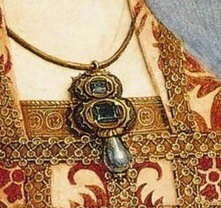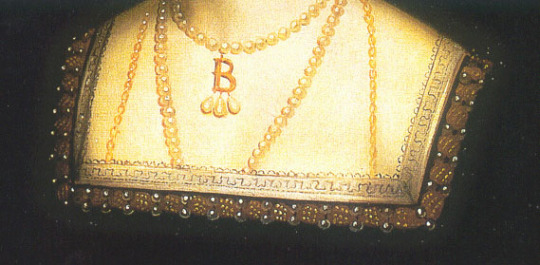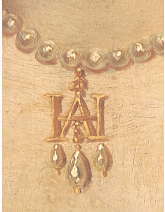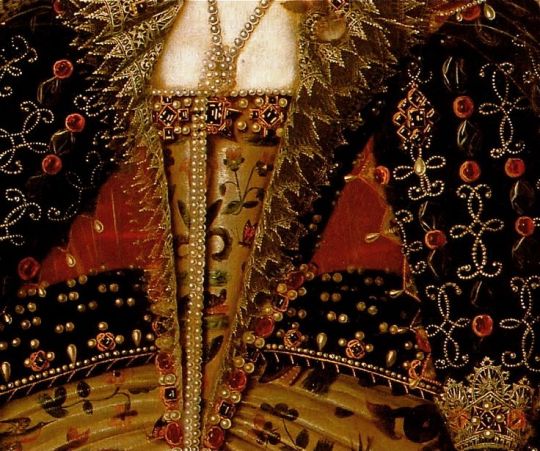There seems to be some misconceptions about the possible fate of Anne Boleyn's jewelry, and so I decided to update this article.
Every queen had a selection of personal jewelry which was not part of the crown jewels. These personal jewels could include gifts from her husband during their marriage, or pieces she owned prior to her wedding. Anne's personal jewelry would not have been considered part of the crown jewels, even after her death and her husband's acquisition of her property.

The crown jewels were a set of gems that were handed down from monarch to monarch. You can see the crown jewels of the Tudor era in the portraits of Henry's queens. The "consort's necklace" is a piece which seems to have been worn by each woman after Anne Boleyn, and it appears not to have been re-set for each queen as many gems were.
Jane Seymour’s portrait is where it first turns up (though Anne may be wearing it in her portrait medallion with a cross pendant.)
Katheryn Howard wears it next.


After that, Kateryn Parr wore it with a different pendant.
A particularly fabulous gem might be added to the crown jewels, but that seems to have depended on the monarch who purchased it - whether he or she wanted to "gift" it to the crown - or how it was purchased (whether with the monarch's privy purse or with the funds of the crown.) The current queen, Elizabeth II, owns many fabulous gems - tiaras, and jewelry sets - that have been passed down through her family that are her personal property and not part of the crown jewels.
 When a queen was widowed, she was expected to turn the crown jewels over to the woman who would take her place as consort, but not the gems that were her personal jewelry. Mary Tudor Brandon caused controversy when she absconded with part of the French crown jewels, including the famous Mirror of Naples, and gave it to her brother in a bid to win his forgiveness for remarrying a man of her own choosing. When King Francis asked for the jewel’s return, Henry argued that the Mirror had been a personal gift from the dead king to his sister, and was not part of the crown jewels.
When a queen was widowed, she was expected to turn the crown jewels over to the woman who would take her place as consort, but not the gems that were her personal jewelry. Mary Tudor Brandon caused controversy when she absconded with part of the French crown jewels, including the famous Mirror of Naples, and gave it to her brother in a bid to win his forgiveness for remarrying a man of her own choosing. When King Francis asked for the jewel’s return, Henry argued that the Mirror had been a personal gift from the dead king to his sister, and was not part of the crown jewels. Anne's famous initial pendants were an example of personal jewelry. Katharine of Aragon also had personal jewels that were not part of the collection she was forced to surrender to Anne Boleyn in 1532. Specifically, she left to her daughter in her will a "gold collar I brought out of Spain."
Anne's famous initial pendants were an example of personal jewelry. Katharine of Aragon also had personal jewels that were not part of the collection she was forced to surrender to Anne Boleyn in 1532. Specifically, she left to her daughter in her will a "gold collar I brought out of Spain." The initial pendants I’ve described Anne wearing in Under These Restless Skies are featured in portraits of Anne Boleyn or her daughter. Since no portraits from Anne's lifetime survive (with the possible exception of the Holbein sketch) it seems likely artists painted Anne wearing pieces of jewelry her daughter had inherited, or pieces that were remembered as belonging to her.
The initial pendants I’ve described Anne wearing in Under These Restless Skies are featured in portraits of Anne Boleyn or her daughter. Since no portraits from Anne's lifetime survive (with the possible exception of the Holbein sketch) it seems likely artists painted Anne wearing pieces of jewelry her daughter had inherited, or pieces that were remembered as belonging to her. Everyone is familiar with the famous “B” pendant, but it appears Anne had several others.
Everyone is familiar with the famous “B” pendant, but it appears Anne had several others.
“AB,” is pictured in one of her portraits, pinned to her bodice in the Nidd Hall portrait.
 An “A” pendant is worn by Elizabeth in the Whitehall Family Group Portrait. (UPDATE: I have been informed that this pendant may have religious significance as opposed to signifying the name "Anne." The pendant may refer to Auspice Maria, or "under the protection of Mary." I need to do further research on this.)
An “A” pendant is worn by Elizabeth in the Whitehall Family Group Portrait. (UPDATE: I have been informed that this pendant may have religious significance as opposed to signifying the name "Anne." The pendant may refer to Auspice Maria, or "under the protection of Mary." I need to do further research on this.) Anne is also portrayed wearing an “HA” pendant, her initials entwined with Henry’s, a design known as a love knot. Holbein is recorded to have designed such a necklace for her; it's tempting to imagine this is similar to the one he created. Inventories also record Anne had items with the initials "RA" Regina Anna (Queen Anne) and a large array of rings, bracelets and other items with "HA" inscribed.
Anne is also portrayed wearing an “HA” pendant, her initials entwined with Henry’s, a design known as a love knot. Holbein is recorded to have designed such a necklace for her; it's tempting to imagine this is similar to the one he created. Inventories also record Anne had items with the initials "RA" Regina Anna (Queen Anne) and a large array of rings, bracelets and other items with "HA" inscribed. It should be noted that some historians now claim the Hoskins miniature, used as the "pattern" for portraits of Anne Boleyn, is actually of Mary Tudor Brandon. However, most nobles of the day did not identify themselves by their surname, but by their title. If Mary wore an initial pendant, it most likely would have had an "S" for Suffolk. Charles Brandon's next wife signed herself "Katherine Suffolk" in documents, just as Anne herself used the name "Anne Rochford" after her father was ennobled, as she signed herself in her only surviving letter to a woman friend, indicating the "B" portrait may portray Anne from a time before that date.
It should be noted that some historians now claim the Hoskins miniature, used as the "pattern" for portraits of Anne Boleyn, is actually of Mary Tudor Brandon. However, most nobles of the day did not identify themselves by their surname, but by their title. If Mary wore an initial pendant, it most likely would have had an "S" for Suffolk. Charles Brandon's next wife signed herself "Katherine Suffolk" in documents, just as Anne herself used the name "Anne Rochford" after her father was ennobled, as she signed herself in her only surviving letter to a woman friend, indicating the "B" portrait may portray Anne from a time before that date. What happened to Anne Boleyn's initial pendants? After Anne died, they became Henry's property, both because he was her widower (though he'd had their marriage annulled) and because she was a convicted traitor. The pieces went into Henry's storage. Some of them were noted as still being in his inventories when he died, but not the initial pendants, so they must have been dispersed before his death. Nor do they turn up in the inventories of his queens.
What happened to Anne Boleyn's initial pendants? After Anne died, they became Henry's property, both because he was her widower (though he'd had their marriage annulled) and because she was a convicted traitor. The pieces went into Henry's storage. Some of them were noted as still being in his inventories when he died, but not the initial pendants, so they must have been dispersed before his death. Nor do they turn up in the inventories of his queens. At some point, Henry seems to have decided to pass the jewels on to Anne's daughter. They were not only an inheritance from her mother, but they were her Boleyn legacy. Henry used his daughter Mary's obstinacy as an excuse not to give her the gold collar her mother had left her, but he had no such excuse in Elizabeth's case. Secondly, though he considered her a bastard, Elizabeth was a king's daughter and had to be groomed and bejeweled appropriately. Giving Elizabeth her mother's personal gems would be a cheap way of fitting her out according to her station. Some believe that Kateryn Parr may have intervened to urge him to give Elizabeth her mother's legacy.
At some point, Henry seems to have decided to pass the jewels on to Anne's daughter. They were not only an inheritance from her mother, but they were her Boleyn legacy. Henry used his daughter Mary's obstinacy as an excuse not to give her the gold collar her mother had left her, but he had no such excuse in Elizabeth's case. Secondly, though he considered her a bastard, Elizabeth was a king's daughter and had to be groomed and bejeweled appropriately. Giving Elizabeth her mother's personal gems would be a cheap way of fitting her out according to her station. Some believe that Kateryn Parr may have intervened to urge him to give Elizabeth her mother's legacy.He doesn't seem to have minded her wearing them. Though he had initially tried to eradicate Anne's memory by destroying her portraits, records, and emblems, he passed on the gems as they were, not bothering with the expense of re-setting them before he had them given to Elizabeth. Elizabeth chose to wear the "A" pendant in the Whitehall family portrait. Perhaps Henry shrugged and said if she wanted to mark herself with the name of a traitor, it was no skin off his nose. She was a bastard ineligible for the throne anyway.
 Elizabeth may have eventually had the "B" pendant remade into the one we see in her teenage portrait wearing the red gown. Historian Eric Ives notes that he three dangling pearls are nearly identical. Elizabeth is not recorded in her later years as wearing her mother's initial pendants. Perhaps by then she felt it impolitic to associate herself openly with Anne, though she may have worn a crown made for her mother for her coronation portrait, and had a ring made which contains an image of her mother.
Elizabeth may have eventually had the "B" pendant remade into the one we see in her teenage portrait wearing the red gown. Historian Eric Ives notes that he three dangling pearls are nearly identical. Elizabeth is not recorded in her later years as wearing her mother's initial pendants. Perhaps by then she felt it impolitic to associate herself openly with Anne, though she may have worn a crown made for her mother for her coronation portrait, and had a ring made which contains an image of her mother.
 So, what happened next? The Tudors were not as sentimental as we are about keeping inherited jewelry intact. Elizabeth would have done as most people and had the pieces re-made to suit the current fashion. Her mother's pearls may have joined the long ropes she wore looped across her bodices, and the gold may have been recast into brooches or rings.
So, what happened next? The Tudors were not as sentimental as we are about keeping inherited jewelry intact. Elizabeth would have done as most people and had the pieces re-made to suit the current fashion. Her mother's pearls may have joined the long ropes she wore looped across her bodices, and the gold may have been recast into brooches or rings.They would have gone to James I when Elizabeth died in 1603. His wife, Anne of Denmark, likely had the pieces melted down and re-set again, as was customary with monarchs. Most of the pieces in royal hands were sold off during the civil wars and the Commonwealth era. They disappear into the mists of history.
It's thought that some of Anne Boleyn's pearls may survive today in the State crown of Queen Elizabeth II. However, the crown was made in the time of Queen Victoria, and there's no direct evidence that the pearls belonged to Anne Boleyn or her daughter.


























